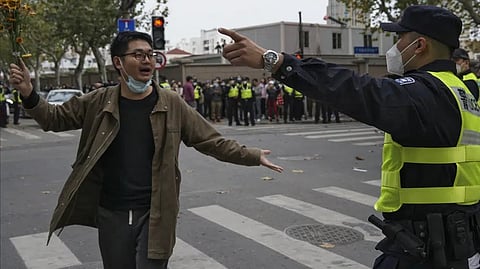

SHANGHAI: The mourners in Shanghai lit candles and placed flowers. Someone scrawled “Urumqi, 11.24, Rest in Peace” in red on cardboard — referring to the deadly apartment fire in China’s western city of Urumqi that sparked anger over perceptions the country’s strict Covid measures played a role in the disaster.
What started as a small vigil last weekend by fewer than a dozen people grew into a rowdy crowd of hundreds hours later. One woman defiantly shouted for Chinese leader Xi Jinping to resign, emboldening others. Then, before dawn, police swept in and broke up the gathering and prevented more from happening.
The Nov. 26 protest in Shanghai wasn’t the first or the largest. But it was notable for the bold calls for change in China’s leadership — the most public defiance of the ruling Communist Party in decades.
Nationalist bloggers swiftly blamed foreign “black hands,” and the government vowed to crack down on “hostile forces.” But the protest emerged spontaneously, according to 11 participants and witnesses interviewed by The Associated Press. It was the first political demonstration for nearly all of them, and they spoke on condition of not being fully identified for fear of police.
Three grinding years of lockdowns under China’s “zero-Covid” policy, along with Xi’s erasure of civil liberties, made the country ripe for such an outburst in a way that nobody expected – not the authorities, the police or protesters themselves.
The vigil on the evening of Saturday, Nov. 26, took place in Shanghai’s French Concession, a trendy district filled with boutique Art Deco cafes, vintage shops and historic Tudor mansions. Among the first there were local artists and musicians, according to two friends of early participants.
One bustling boulevard is named after Urumqi — the city in the far-northwestern Xinjiang region where the Nov. 24 fire killed at least 10. Many criticized government Covid restrictions for preventing victims from fleeing, a charge the authorities denied.
Anger soon flared on Chinese social media. Millions of online posts blamed virus control barricades for delaying rescuers, and Urumqi residents hit the streets to protest their months-long lockdown.
Visit news.dtnext.in to explore our interactive epaper!
Download the DT Next app for more exciting features!
Click here for iOS
Click here for Android